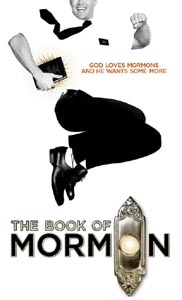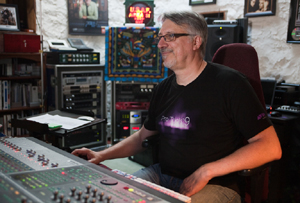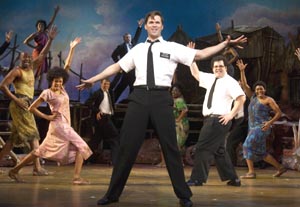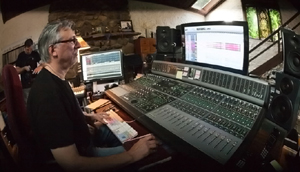Inside “The Book of Mormon” Cast Recording: Frank Filipetti Breaks Broadway’s Rules
WEST NYACK, NEW YORK: Whether or not you can handle the message, there’s no denying the music. The Book of Mormon is a Broadway score that has you locked in from the first downbeat and doesn’t let go – even after its vanished from your ears, these songs are stuck fast in your head.
When the legendary NYC-based producer/engineer/mixer Frank Filipetti accepted the mission to track and mix the Mormon Broadway cast album, he knew what he was getting into. The book, lyrics and music are by none other than Trey Parker, Matt Stone, and Robert Lopez – the first two being the manic genius talents behind “South Park“, and the latter well known for co-writing and co-composing Avenue Q. The result is an alternate-dimension tale of two Mormon missionaries arriving in Uganda, a plot line tailor-made for these satirical masterminds.
For all who remember the blitzkrieg of classic, hook-laden show tunes from the 1999 feature film South Park: Bigger, Longer and Uncut, it should be no surprise that Mormon takes that all up 100 levels. And for once, the critics and the public alike agree that something is totally rad: since debuting in March tickets are almost impossible to get, the show has garnered 14 Tony Award nominations, and the album’s May iTunes release has seen it become the fastest-selling digital release of a cast recording ever. The album’s physical release this week to brick & mortar stores may see even more records fall.
But capturing all these groundbreaking gags in perfect harmony wasn’t easy: Filipetti and his team also broke the rigid rules of Broadway to record and mix it the right way. Filipetti’s heavy cast album credits include Annie Get Your Gun, A Funny Thing Happened on the Way to the Forum, Aida, and many more – here he tells us how they got the sound of Mormon out to a grateful planet.
Once you were on board, how did you plan out the recording of The Book of Mormon?
With Broadway shows, you’re kind of locked into a very particular way of recording cast albums, mostly because of union rules. They make the recordings of Broadway albums unnecessarily difficult and stressful, because you have to deal with these arcane rules, which were relevant 60 years ago but are no longer based on the way that current recordings are made.
So traditionally a Broadway cast recording is a 15-hour day in which you record the entire album: the instruments and the vocals are all tracked together. It’s definitely the hardest, most demanding thing we do. Then we spend several days editing the recordings into complete takes, as there is no time to do that in session. You can’t do overdubs because you have to pay the singer a week’s salary even if they’re only in for 15 minutes. So you do the entire recording in one day.
The Book of Mormon is a very complex score – the songs were written and composed by Trey Parker, Matt Stone and Robert Lopez. We decided early on we would do it differently than most Broadway shows: that we’d record the musical tracks first, then get a day with the cast.
What did you have to do differently to pull that off?
Usually, you don’t record the musical/instrumental tracks without the singer there, because the singer generally controls the tempo…how they’ll phrase a certain section.
But (conductor) Steve Oremus is a human metronome, along with drummer Sean McDaniel. They’re so good at knowing what the singers will be doing — without using a click — that we decided we could get away with it. That would make our job easier, because the arrangements have vocal parts within vocal parts within vocal parts. Trying to do all of that with the principal singers, rhythm section, orchestra, all in two or three takes in an all-day session wasn’t going to work.
So we cut the orchestra in one day at MSR Studio A, edited the takes together over the next couple of days, and then came back in with the singers and did one day with them.
Were Matt Stone and Trey Parker in the studio for the sessions as well?
They were there for the recording of the music and the vocals, but they were more involved on vocal day than on orchestra day, which they left more to Bobby Lopez and Steven.
For them the main concern was the characters and making sure the jokes were coming across. For the vocal session, there were a lot more people who were concerned and involved in the recording process.
What were you recording through and to on both days?
We recorded to Pro Tools. Since it was going to CD, and as it was going to be – I realized – a very track-laden recording with between 70 and 120 tracks, I did it at 44.1 kHz. We recorded on the SSL 9000K at MSR studio A, using their 48 Neve 1081s that they have patched in.
It sounded great. I love working there, because you’ve got an SSL 9K for the clean signal, or you can go for the Neve, punchier rock and roll thing. We were able to mix and match.
Did you use Pro Tools 9 on this project?
I’ve been using HD9 since it came out, 7 or 8 months ago. I switched over to Pro Tools around the time of HD8, mainly because when I moved up here to the Living Room, instead of bringing my System 5 console up with me, I decided to go with the Digidesign D-Command. So I bought a 24-fader D Command, and moved the rest of my Studio B gear in Manhattan to my studio here at home.
I believe Book of Mormon was my first all-HD Native project. I’d been using HD9, but not 9 HD Native. My TDM system consisted of a 4-core Mac Pro that I had been using for the last couple of years, two HD192’s and a Digidesign Sync box, but just prior to this project I purchased a new 12-core Mac Pro.
Robert Miller at Avid suggested I try the HD Native card with my new system and see how that would work. I must say, it was, quite simply…incredible. I absolutely love it! I used to work in Pro Tools but mix to Nuendo, because of what I considered to be sound benefits. But with HD Native I don’t feel that’s necessary anymore, so now I’m doing everything in Pro Tools.
When it came time to mix, please explain how your studio upstate is laid out for the job.
Once the vocals were cut, I took the hard drive to my place up in West Nyack, the Living Room. I had my assistant Derik Lee start working on cleaning the tracks for mixing and editing. He and Steven Oremus would also comp the vocals and send them to me for mixing. That was all happening while I was concentrating on the mix process itself.
The Living Room is an incredible-sounding room. It’s about 32’ x 24’, two stories high, with wood beam cathedral ceilings, all stone. The room was built in 1870, so it’s got 12-inch thick stone walls, and it’s as solid a room as you could ever imagine. It has a fireplace, which I have going in the wintertime… skylights for the spring, summer and fall. Sunlight instead of a dimly lit dungeon, which is how I mixed for many, many years.
What’s the workflow?
It’s all here at my desk. I’ve got a 5.1 system set up and ready to go, a 42” Sony HD monitor for Pro Tools, and a 26” Gateway HD monitor as a second screen.
I’ve got a wall filled with analog gear. That includes eight Neve 1081’s, eight Neve 1064’s, Pultecs, Tube Techs, Massenburg EQs and pre’s, Neve 33609, LA-2As, 1176s’, Chandler EMI pre’s, APIs, SSL xLogic pre’s, AMS verbs and delays as well as a host of digital gear including 2 Lexicon PCM 96’s, Lex 960, TC 6000 and on and on. My entire system is being run off an Antelope Atomic Clock, and I’m using the Lavry Blues for AD and DA. All the stuff that I could hope for in the studio, all at my beck and call.
When people come in, they’re expecting a home studio. But this is not a home studio; it’s a studio that happens to be in my home! It’s a huge room, extremely comfortable, and it needed no wall treatments at all. They don’t build ‘em like this anymore. It just sounds amazing. The only thing I do have is my Audyssey MultiQ system, which tunes my 5.1 JBL 4300s, but other than that, it is as it is.
How would you describe the Book of Mormon music, and what was your approach to mixing it? What did you feel were the challenges and opportunities in mixing it?
Well, part of the challenge was the complexity of the score…there are a lot of people singing a lot of different melodies and lyrics simultaneously. So the main thing for me was creating enough air and clarity for all the vocalists while still maintaining the vibrancy of Bobby’s orchestral arrangements.
It’s also a very “Broadway” score, along with a couple of African-based numbers. So it presented a wide range of styles to deal with, from traditional Broadway ballads, tap numbers, full-on chorus, dance, jazz, rock and African numbers. It was a very challenging score. Bobby writes very unique and interesting music. And along with Trey and Matt’s lyrics, it’s just brilliant AND hysterically funny.
But of course with budgets as they are, you don’t get a lot of time to mix. So the challenge for me was getting everything done in the time allotted, and hopefully sounding good.
Are there techniques you employ that are unique to Broadway musicals, especially when it comes to keeping space around the vocals as you mentioned?
There are several things. I usually sub-mix the bass, drums, strings, vocals, keys, etc.… so at the end I’m not dealing with 120 faders; I’m probably dealing with 12-24. So if I need to scoop out some frequencies to make a vocal happen a little better from the orchestra, I can do it over the sub buss.
Also, I’ll use the vocal buss to frequency limit and to side-chain a compressor on the band, in order to make room that way. Keep it subtle, and keep it out the way of everything, so people don’t notice it.
I have the principal vocals on a buss, then the background vocals, and the chorus vocals on a buss, sometimes on two busses, depending on the different parts. I played around a bit. On one song I had the background vocals on three busses to make them work better with each other — I believe that was on the finale (“Tomorrow is a Latter Day”).
But helping me in getting this clarity was something I noticed immediately mixing in HD Native. I found what I consider a lot more air and headroom then I did in the TDM system. With my older system, I felt compelled to be vigilant over internal digital levels. Because I was using a template set up in my TDM system, by the time I got to HD Native I had headroom for days.
So do you do a lot of panning and EQ to keep the vocal tracks spaced properly?
Anything you can think of doing is probably being used. I don’t work under any rules. If I have two separate parts going on at the same time, rather than having them both in the stereo field confusing each other, I’d put one on the right and one on the left, EQ one brighter than another, split the men on one side and the women on the other, side-chain compress them….
I don’t use just stereo reverbs – I’ll use two, three or more mono verbs as well. Sometimes, if I’m putting the vocal to the left, I’ll put a mono reverb behind it, or alternatively put the verb to the opposite side. When mono reverbs are reverse panned, it gives the tracks space without taking up space: the sound is big, but with a clarity that a stereo spread with a stereo verb would lack. It all depends on the part that’s involved.
That’s quite a trick!
Certainly not a new one, but nowadays people tend to work with everything in stereo, and panned in stereo. But the bottom line is that back in the analog days, you only had one or two EMTs — this is the kind of thing we used to do all the time.
How did you handle the long-distance workflow? Tell us about the logistics inherent in that.
The principals – Steven, Bobby, Matt and Trey –were all in the city and I was mixing up here. So I set up Source Connect so they could listen in on my session anytime in real time. They just had to log on to the session and hear in high res audio exactly what I was doing. We used that along with video from Skype, and pretty much mixed it as if they were in the room with me, only they were in Manhattan and I was in West Nyack.
It’s really amazing, these tools we have now. Steven would call up listening at his home, on his own speakers, sometimes at two or thee in the morning — on something he’s totally used to. The fact that it’s real time and hi res, as opposed to your standard 192 kHz MP3, allows them to call in from anywhere they want to listen and make changes in real time.
So does that mean the mix goes a lot faster?
Not necessarily. The ability to do all these things sometime makes your life easier and faster. But sometimes it doesn’t because when people realize they can change things instantly…some people can’t stop doing that!
In this instance, the downside was that Steve, Bobby and I had come to a general idea on the record, but with the other people involved – Matt, Trey, Scott Rudin, Kurt Deutch and a host of others on the production staff – things got a little messy. The more cooks you have, the more people listening in…it can get dangerous. Yes, you can dial in and listen to my mixes anytime, but 2-3 days before mastering we were scrambling and working massive days, because the comments came flying at the last minute. Suddenly you’re getting tons of input from people who hadn’t listened to stuff earlier, so we were right up to the wire.
When you’re dealing with just one producer, it’s a different story. Subsequent to this, I mixed Baby it’s You with one producer and the mixes went much more quickly. It depends on who’s involved, their pressures — just so many variables.
The musical’s popularity exploded while you were in the process of producing this album. Did that affect things?
As we were in the mixing process, they went from previews into the official opening, and the reviews that came back were so frighteningly good that it took on a much higher profile then when we started.
There was a little buzz early on about Matt and Trey, but all the other Broadway buzz was about Spider-Man. Mormon was a little under the radar. When the critics were floored by it, the stakes got a lot higher and it became a different thing.
What do you think this soundtrack represents in the evolution of Broadway cast recordings? How does it manage to be old school and new school at the same time?
What I think it represents is a fact that you can be old and new and hip and subversive and cool and still heartwarming at the same time. I think one of the things that the score’s writers have managed to do on this is to reinvent the old Broadway musical and make it hip.
A lot of musicals are trying to break the tradition of Broadway, whether it be Spider-Man, American Idiot, Fela — all these musicals try and go in a slightly new direction and change the characteristics of the Broadway musical, to make it hipper. They’re all cool in their way, but this is a traditional Broadway musical that spins your head around 360 degrees. You’re all of a sudden in the middle of something extremely subversive, truly cool, and truly funny. It doesn’t matter your political persuasion, whether you’re old or young, there’s something in it that’s just amazing for everybody.
And at the end of the day, it does end up being about the music: It’s beautiful and clever and intellectually written, both music and dialogue. I think it’s an album like Wicked, which I did back in 2003, and I still listen to because it’s wonderful music. The Book of Mormon is the same kind of thing: You’ll be listening to it years from now.
— David Weiss
Please note: When you buy products through links on this page, we may earn an affiliate commission.










